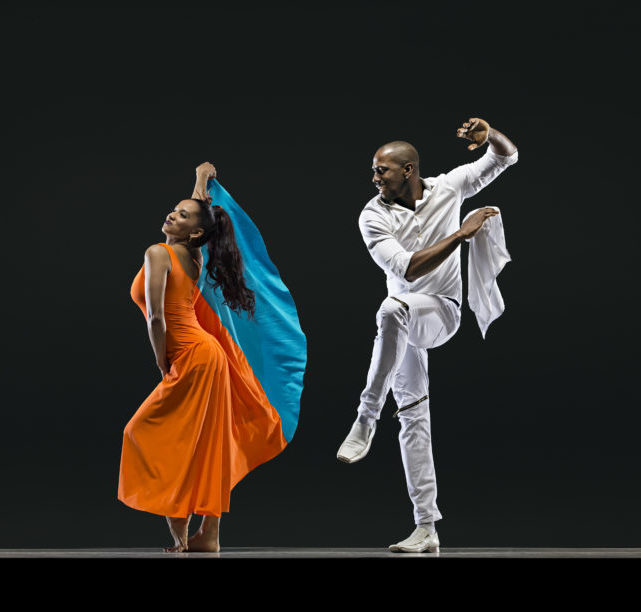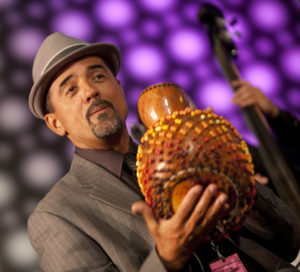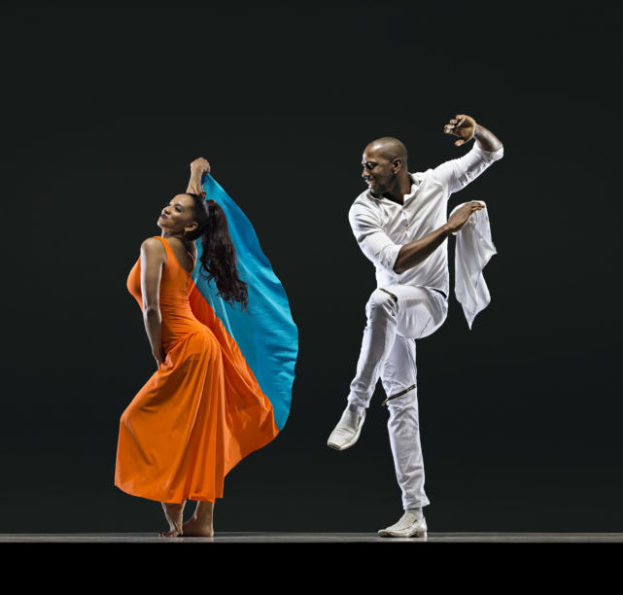
This year, the San Francisco Ethnic Dance Festival (SFEDF) takes place for the first time at the San Francisco War Memorial Opera House. It is also the first year that the festival will present the work of Cuban choreographer Ramón Ramos Alayo and the Alayo Dance Company. Festejos Caribeños, a collaboration between Alayo and renowned Afro-Latin percussionist John Santos and his sextet, and commissioned by the SFEDF, is an enactment of a Cuban street party in three parts, each dominated by a different dance form: Modern Dance, Rumba, and Conga. Each form bleeds into the other, laced with a fourth form, Cuban Salsa. The work begins with a New Orleans-style funeral procession and ends with an invitation to join the Conga line. (NB: This is not the “one-and-two-and-three, kick!” of your nephew’s Bar Mitzvah.)
Alayo has been working in the Bay Area as a choreographer for nearly two decades—he founded Alayo Dance Company in 2002—and has organized the successful Cuban dance festival, Cuba Caribe, for the past 13 years. So it surprised me to hear that this was the first year his work was to be featured at the SFEDF. But Alayo explained that the way his choreography combines dances from Africa, Latin America, the US, and Europe has, in the past, been somewhat illegible to presenters looking for cultural forms that appear to have been spawned within clearly defined national borders: “Once I auditioned and brought a modern piece. They didn’t accept me. But this time they want to bring some modern into it.” In other words, dances from Cuba needed to look Cuban in the eyes of the presenters; traces of petit allegro or fall and recovery didn’t seem to go with percussive, polyrhythmic pelvic movement.
Thankfully, the SFEDF currently understands that “ethnic” dances are dynamic, hybrid practices rather than static, monocultural forms; they develop in non-linear time and multidirectional space. The audition guidelines call for “dances that reflect all aspects of culture, including sacred or spiritual dances, social dance, secular or vernacular dance, dances from life cycle events, and innovative work based in traditional dance forms.” Ethnic dance festivals, in their effort to showcase diversity under the banner of multiculturalism, risk conceiving of and promoting dance forms that are “recognizably” Other, perpetuating simplistic binaries such as traditional/contemporary and ethnic/art. But the SFEDF’s panel review criteria includes a section on the “Relationship to Cultural Origins – Authenticity and/or Genre Growth,” asking whether a work of “hybrid genre or fusion […] successfully integrates the disparate movement vocabularies as well as demonstrate technical and cultural understanding of its disparate roots.”
Alayo explained that since the 1959 Cuban revolution, Cuban dance has been a mixture of modern dance, ballet, and folkloric forms. To complete his Master of Arts at the National School of Art in Havana, Alayo trained for eight years in multiple dance forms including Cuban dance, folkloric dances from other Latin American countries (Colombia, Mexico, Panama, Venezuela), Yoruban dance, Haitian dance, modern dance (Horton, Limón, and Graham), and ballet: “All my life I have been mixing genres and styles.” To account for this complexity the festival is calling his work “Cuban Contemporary Folkloric,” “because I’m not doing a pure folklore. I’m modifying the Rumba a little bit, like with lifting [one person lifting another] from modern dance. They call it contemporary because it’s not a traditional Rumba or Salsa.” Since Alayo trained in Cuba at a school where contemporary and folkloric forms occupy a level playing field characterized by cross-pollination, it seems to me that “Cuban dance” would have been the more appropriate and accurate moniker.
Despite efforts by dance scholars to challenge aesthetic hierarchies that place “traditional” or “folkloric” dance forms below “concert” or “art” dances alleged to have universal reach and a capacity for transcendence, these hierarchies remain. [see footnote 1] “Not for Cuba,” Alayo said.
“When you start choreographing, you can mix all those dances, there’s a lot of connection.” This interaction and exchange of forms that began after the revolution continues to change: “Cuban modern is changing because now they are bringing companies from Europe, who don’t know what Cuban dance is.”

Santos, who was born and raised in San Francisco to Puerto Rican and Cape Verdean parents, further discussed how we misunderstand the term traditional: “The forms that we are using here in this instance are super traditional dance forms but even in that context, even saying they’re traditional, they have to be understood as all about improvisation and creativity. It’s not a staid, under-glass, museum tradition. It’s a living tradition that has always evolved.”
In terms of labels like “Afro-Latin music,” Santos said, “They mean nothing. They’re commercial labels, made mainly for the industry, so the people selling the music know what bin to put it in.” Nevertheless, certain commercial labels often have complex histories, particularly among the musicians who find themselves under their jurisdiction. Santos explained, “To call music Afro-Latin, for example, does have a certain connotation and it means different things to different people. We’re dealing with Afro-Cuban music in this case, but we don’t call the music I play in general Afro-Cuban anymore. Afro-Cuban is the strongest root, but it would be limiting to call it that since we put in all our collective lines—jazz, funk, rock, classical, Puerto Rican, Brazilian. In Dizzy Gillepsie’s time, the 40s and 50s, it was Afro-Cuban jazz, not Afro-Latin. But as years went on, the Caribbean adopted it all, so now you can’t just say Afro-Cuban.” Afro-Latin Jazz works to account for that hybridity, but tensions among artists around labels continue: “There was a time not long ago when Cubans hated the term Salsa because it was a Puerto Rican term. We know it has mostly Cuban roots—it’s rumba, it’s son, it’s mambo—but the Puerto Ricans promoted it in New York. Now many Cubans say Cuban Salsa.”
Santos’ recordings provided the point of departure for Alayo’s choreography: “Ramón listened to several of my pieces and identified the ones that spoke to him. Then we took two separate pieces and made one new piece. Ramón gravitated towards the pieces that were most danceable.” Alayo worked with the dancers to the recordings and then showed Santos the choreography. I asked Santos how working with a choreographer and dancers affects his practice: “Whenever there is choreography we have to pay close attention for cuing, for the vibe and spirit of the piece. That’s what makes it special.”
Although working with choreography may be a special circumstance for Santos, working with dance in mind is not: “In order to play traditional Cuban music you have to learn it in the context of dance. I’ve been around that type of dance my whole life. When performing, composing, and recording music that is based on traditional forms, like rumba and conga, I visualize the dancing. The dancing is part of my process, even when there’s no dancing involved directly; the music is made for dancing. Most of our music is based on dance forms. So it’s a natural fit.”
When I told Santos about Alayo’s past illegibility in the eyes of the SFEDF audition panelists (and surely there were more variables in the decision than can be accounted for here), he was surprised: “What he was presenting should have fit all along. It’s what’s going on in Cuba. You now see modern, hip hop, Michael Jackson, boxing, baseball, in traditional rumbero dancing. It’s open to everything, so it’s logical to a dancer who studies modern and ballet, and who sees rumberos in the street.”
As the festival continues in our post-/neo-colonial, globalized world, it is important, perhaps now more than ever, that it presents artists like Alayo, whose artistic practices embody the tensions that challenge the concept of “ethnic dance” as it developed in the context of colonialism. As anthropologist Joann Kealiinohomoku argued in her groundbreaking 1969 essay, “An Anthropologist Looks at Ballet as a Form of Ethnic Dance,” all dances are ethnic dances, even ballet. [see footnote 2] And all dances are hybrid forms developed in the context of global flows of human capital, even ballet (Italian, French, Russian, Chinese, Cuban). Despite the fact that hybridity, creativity, and a notion of the contemporary characterizes all dances of modernity, the label “ethnic” continues to operate as a euphemism for “other,” for world dances that are somehow not of this world.
Ballet, with its high level of infrastructural and financial support, doesn’t need a platform like the SFEDF. Even if he isn’t fond of the pressure to be “the representative of tradition” (and the concomitant critiques for being not authentic enough), Alayo appreciates how the SFEDF offers a forum for the rich Bay Area dancescape. Both he and Santos feel that the festival is particularly important right now. Santos said, “It has a special significance to be in that environment where there’s music from around the world; it frames current political discourse and divisiveness differently by demonstrating unity and solidarity across all real and perceived borders.”
SF Ethnic Dance Festival presents Alayo Dance Company and John Santos’ Festejos Caribeños: Jul 8-9 (full festival runs Jul 8-9 & 15-16), War Memorial Opera House, SF, sfethnicdancefestival.org
[1] For an excellent discussion of the discursive history of “ethnic dance,” see the edited collection Worlding Dance, edited by Susan Leigh Foster.
[2] In her chapter in Worlding Dance, “Race-ing Choreographic Copyright,” Anthea Kraut makes a crucial point about Kealiinohomoku’s groundbreaking 1969 essay, “Despite her efforts, the constructed opposition between the solitary, creative genius of the West and the collectively created dance cultures of the Rest continues to hold sway” (78).


